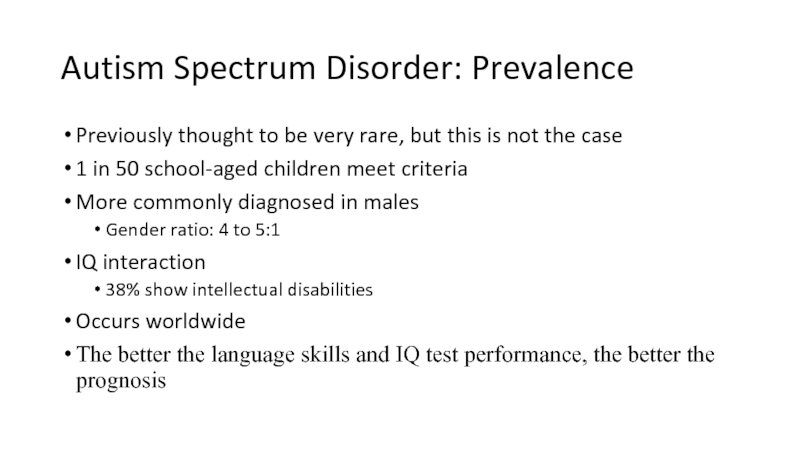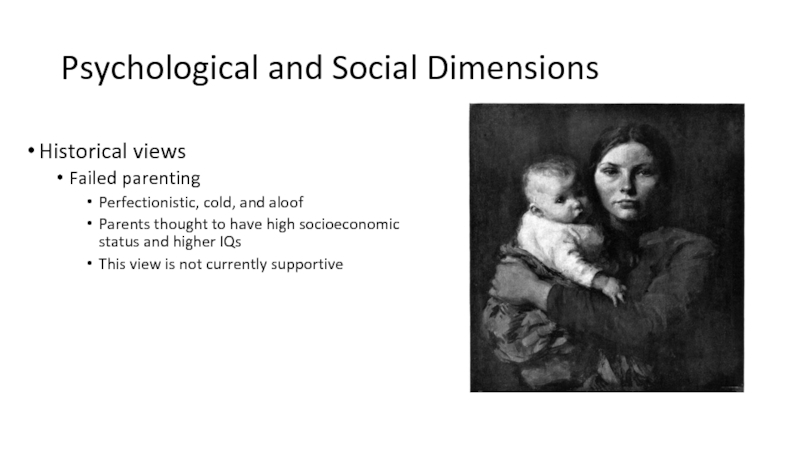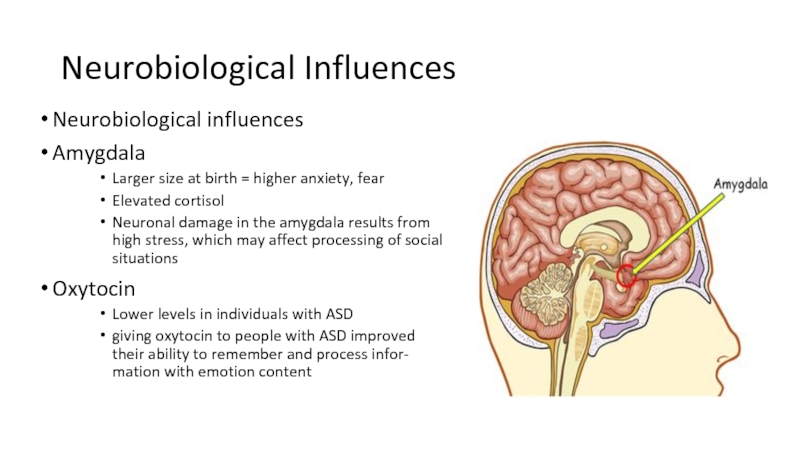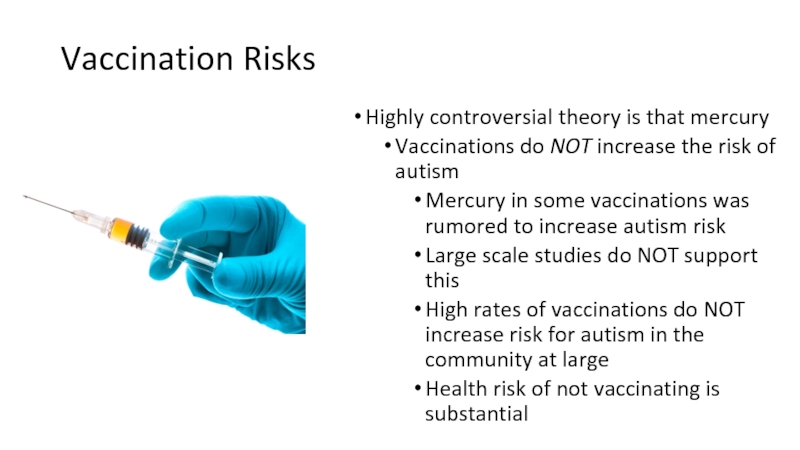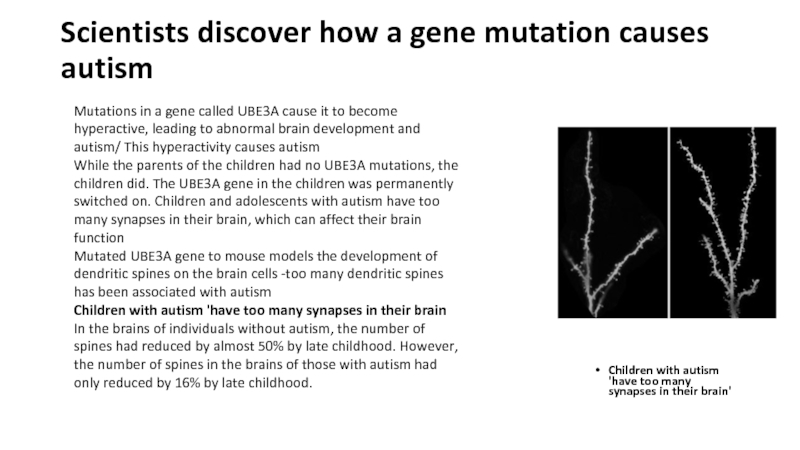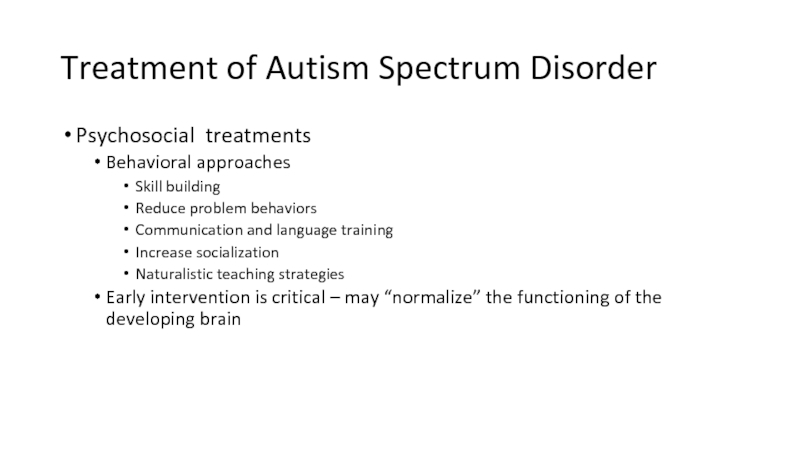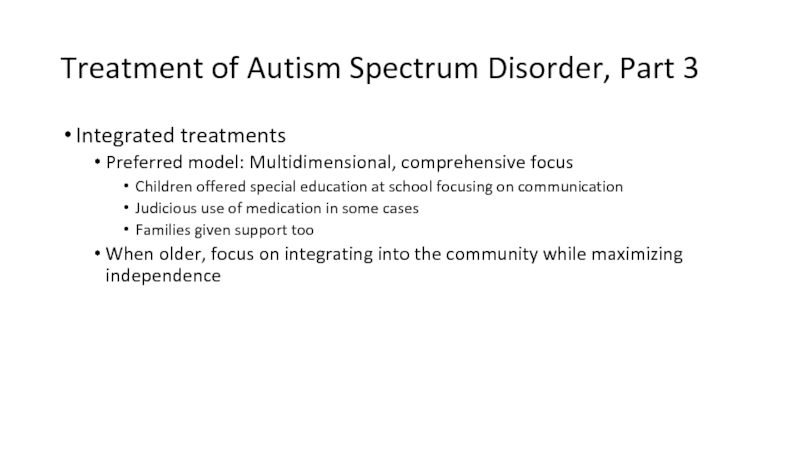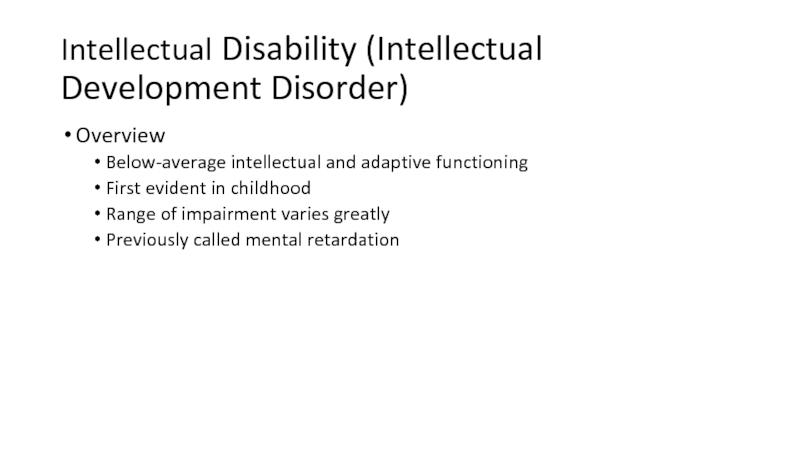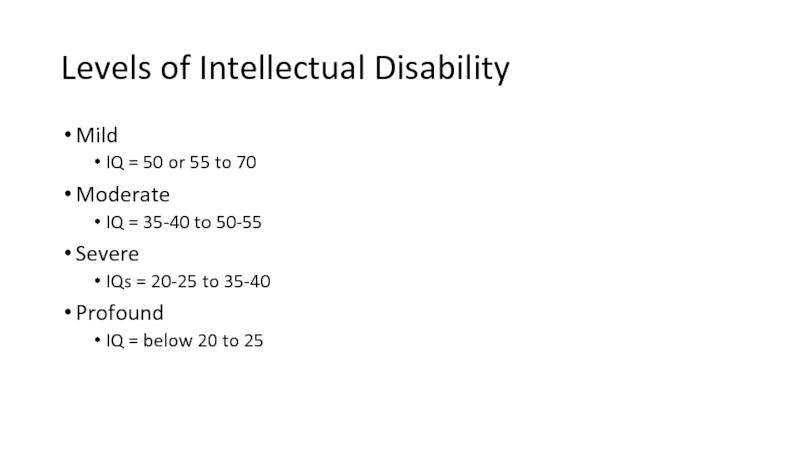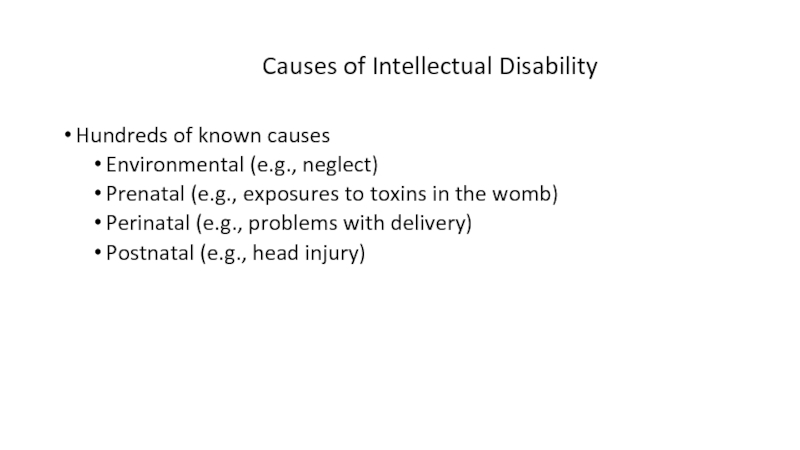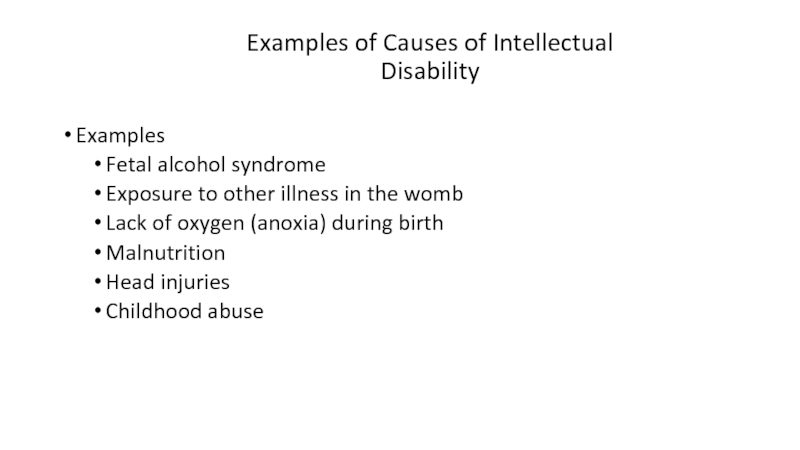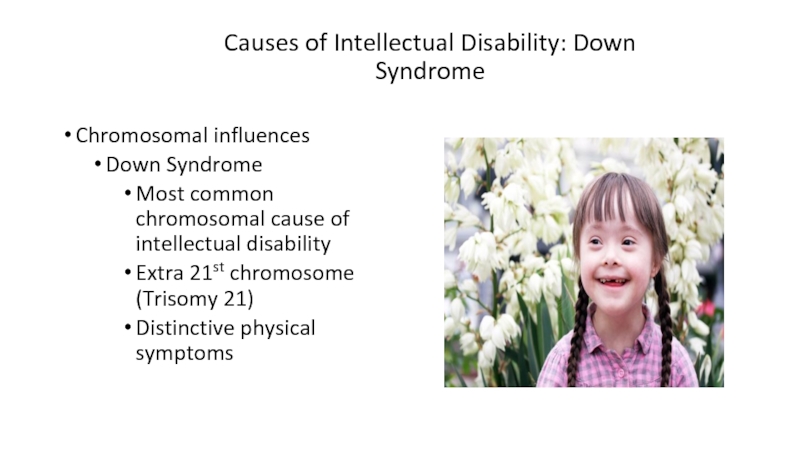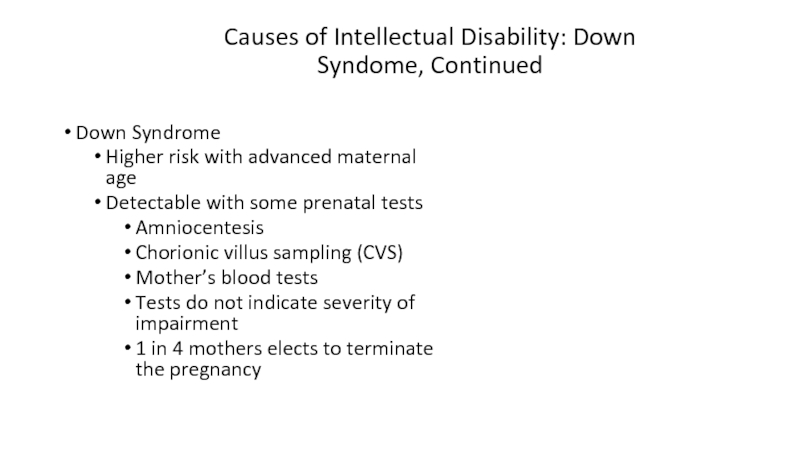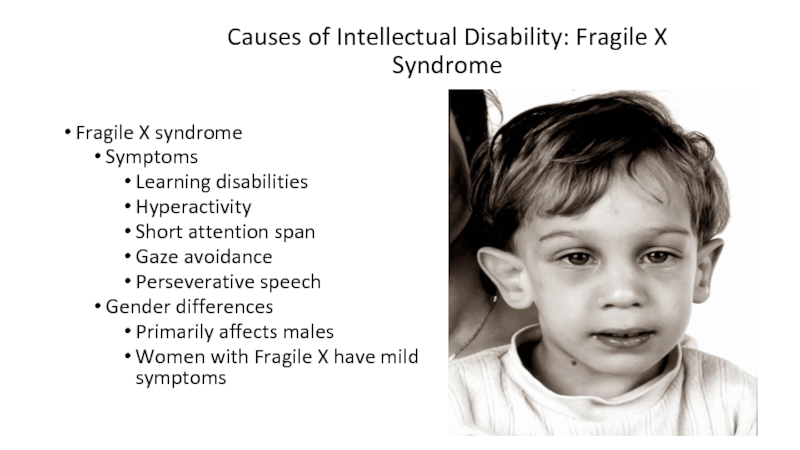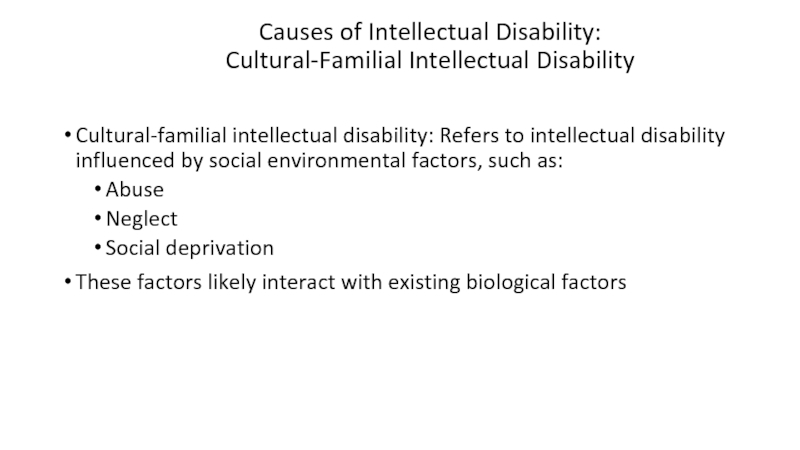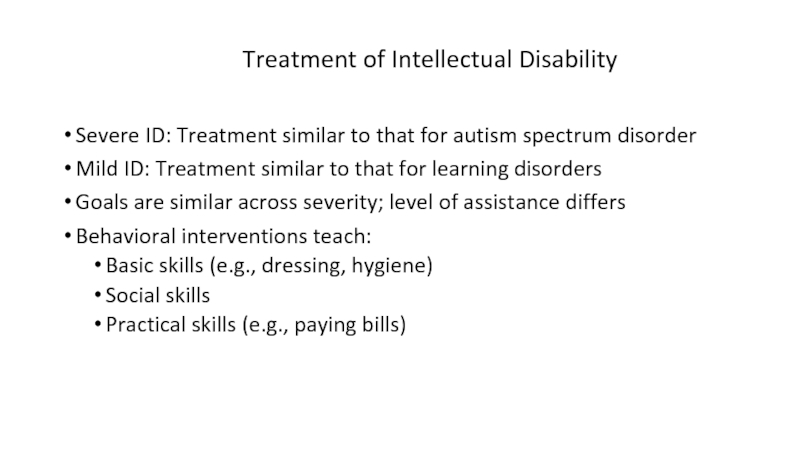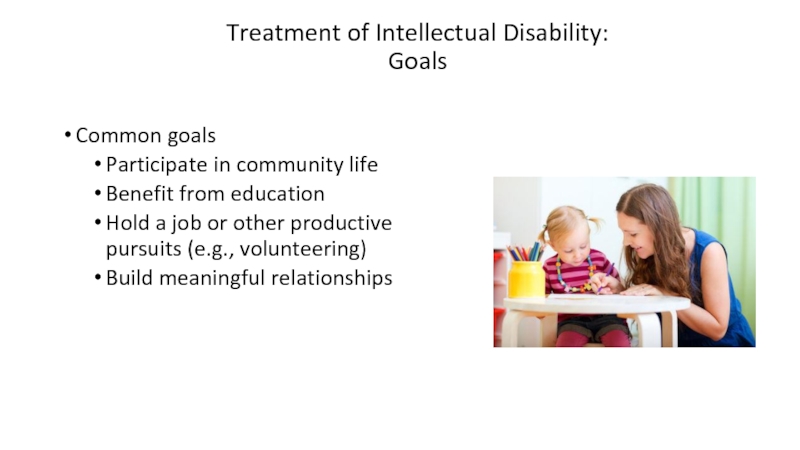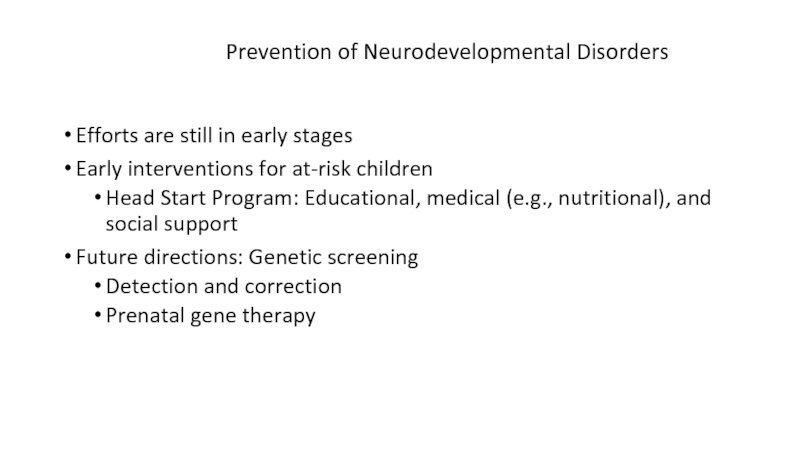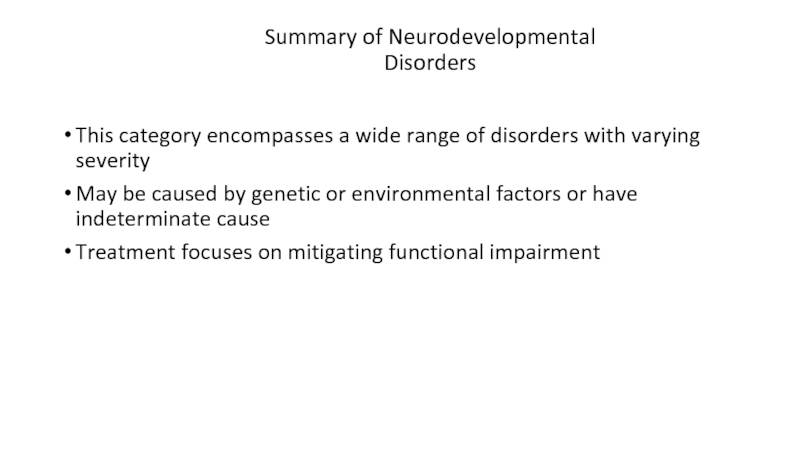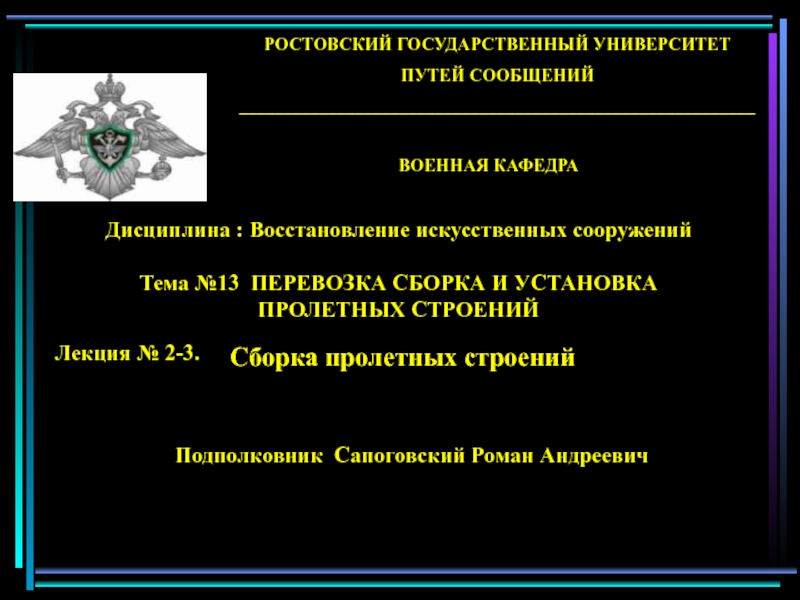Разделы презентаций
- Разное
- Английский язык
- Астрономия
- Алгебра
- Биология
- География
- Геометрия
- Детские презентации
- Информатика
- История
- Литература
- Математика
- Медицина
- Менеджмент
- Музыка
- МХК
- Немецкий язык
- ОБЖ
- Обществознание
- Окружающий мир
- Педагогика
- Русский язык
- Технология
- Физика
- Философия
- Химия
- Шаблоны, картинки для презентаций
- Экология
- Экономика
- Юриспруденция
Chapter 14 Neurodevelopmental Disorders
Содержание
- 1. Chapter 14 Neurodevelopmental Disorders
- 2. OutlineOverview of Neurodevelopmental DisordersAttention Deficit/Hyperactivity DisorderSpecific Learning
- 3. Focus QuestionsWhat are the defining features of
- 4. Neurodevelopmental DisordersDiagnosed first in infancy, childhood, or
- 5. Nature of Developmental Psychopathology: An OverviewNormal vs.
- 6. Stuttering Cluttering -rapid and/or irregular speech ratecausative gene mutations linked to stuttering
- 7. Слайд 7
- 8. Слайд 8
- 9. Attention Deficit/Hyperactivity Disorder (ADHD)Nature of ADHDCentral features
- 10. Types of Attention Deficit Hyperactivity Disorder Subtypes(ADHD)InattentiveHyperactive/impulsive Combined
- 11. ADHD: Facts and Statistics PrevalenceOccurs in approximately
- 12. Test ADHDThe 'Unofficial' ADHD Test for Adults https://youtu.be/iozAFIr3BEw till 12min 24Test https://totallyadd.com/do-i-have-add/
- 13. ADHD: Facts and Statistics, ContinuedCourse of ADHDSymptoms
- 14. Causes of ADHD: Biological Contributions Genetic contributionsADHD
- 15. Causes of ADHD: Psychosocial ContributionsPsychosocial factorsADHD children
- 16. Treatment of ADHDGoal of biological treatments: reduce
- 17. Надо какое ниб упражнение
- 18. Specific Learning Disorders: An OverviewScope of
- 19. Specific Learning Disorder: TypesWith impairment in reading,
- 20. Specific Learning Disorder: StatisticsPrevalence of learning disorders5
- 21. Specific Learning Disorders: Statistics, ContinuedStudents with learning
- 22. Causes of Specific Learning DisorderGenetic and neurobiological
- 23. Neurological Differences in Dyslexia
- 24. Treatment of Specific Learning DisorderRequires intense educational
- 25. Autism Spectrum DisorderProblems occur in language, socialization,
- 26. Autism Spectrum DisorderLabel is new to DSM-5Encompasses
- 27. Rett Syndrom
- 28. Impairment in Social Communication and Interaction Defining
- 29. What Autism Looks Like[INSERT Photo, p. 526 HERE]
- 30. Restricted or Repetitive Behaviors and InterestsPreference for
- 31. Autism Spectrum Disorder: Prevalence Previously thought to
- 32. Psychological and Social DimensionsHistorical views Failed parentingPerfectionistic,
- 33. Biological DimensionsSignificant genetic componentFamilial component: If you
- 34. Neurobiological InfluencesNeurobiological influencesAmygdalaLarger size at birth =
- 35. Vaccination RisksHighly controversial theory is that mercuryVaccinations
- 36. Scientists discover how a gene mutation causes
- 37. Treatment of Autism Spectrum DisorderPsychosocial treatmentsBehavioral approachesSkill
- 38. Treatment of Autism Spectrum Disorder, Continued Biological
- 39. Treatment of Autism Spectrum Disorder, Part 3Integrated
- 40. Intellectual Disability (Intellectual Development Disorder) OverviewBelow-average intellectual
- 41. Intellectual DisabilityIQ typically below 70 to 75Previously
- 42. Levels of Intellectual DisabilityMildIQ = 50 or
- 43. Intellectual Disability, DSM-5DSM-5 identifies difficulties in three
- 44. Other Classification Systems for Intellectual DisabilityAmerican Association
- 45. Intellectual Disability: StatisticsPrevalence = 1 to 3%
- 46. Causes of Intellectual DisabilityHundreds of known causesEnvironmental
- 47. Examples of Causes of Intellectual DisabilityExamplesFetal alcohol
- 48. Causes of Intellectual Disability: GeneticsGenetic influencesChromosomal disorders
- 49. Lesch-Nyham syndromeGenetic influences: De novo disorders (=
- 50. Phenylketonuria (PKU)Treatment at any time during pregnancy
- 51. Causes of Intellectual Disability: Down SyndromeChromosomal influencesDown
- 52. Causes of Intellectual Disability: Down Syndome, ContinuedDown
- 53. Causes of Intellectual Disability: Fragile X SyndromeFragile
- 54. Causes of Intellectual Disability: Cultural-Familial Intellectual DisabilityCultural-familial
- 55. Treatment of Intellectual DisabilitySevere ID: Treatment similar
- 56. Treatment of Intellectual Disability: GoalsCommon goalsParticipate in
- 57. Prevention of Neurodevelopmental DisordersEfforts are still in
- 58. Summary of Neurodevelopmental DisordersThis category encompasses a
- 59. Скачать презентанцию
OutlineOverview of Neurodevelopmental DisordersAttention Deficit/Hyperactivity DisorderSpecific Learning DisorderAutism Spectrum DisorderIntellectual Disability (Intellectual Development Disorder)Prevention of Neurodevelopmental Disorders
Слайды и текст этой презентации
Слайд 2Outline
Overview of Neurodevelopmental Disorders
Attention Deficit/Hyperactivity Disorder
Specific Learning Disorder
Autism Spectrum Disorder
Intellectual
Disability (Intellectual Development Disorder)
Слайд 3Focus Questions
What are the defining features of ADHD?
What is a
specific learning disorder?
What are the major features of autism spectrum
disorders?How is intellectual disability defined?
Слайд 4Neurodevelopmental Disorders
Diagnosed first in infancy, childhood, or adolescence
Include the following:
Attention
deficit hyperactivity disorder (ADHD)
Specific learning disorder
Autism spectrum disorder
Intellectual Disability
Communication and
Motor DisordersСлайд 5Nature of Developmental Psychopathology: An Overview
Normal vs. abnormal development
Consider age
and environment of child
Developmental psychopathology
Study of how disorders arise and
change with timeDisruption of early skills can affect later development
Caution: do not excessively pathologize childhood behavior that is part of normal development
Слайд 6Stuttering Cluttering -rapid and/or irregular speech rate
causative gene mutations
linked to stuttering
Слайд 9Attention Deficit/Hyperactivity
Disorder (ADHD)
Nature of ADHD
Central features – inattention, overactivity, and
impulsivity
Associated with numerous impairments
Behavioral
Cognitive
Social and academic problems
Слайд 10Types of Attention Deficit Hyperactivity
Disorder Subtypes(ADHD)
Inattentive
Hyperactive/impulsive
Combined
Слайд 11ADHD: Facts and Statistics
Prevalence
Occurs in approximately 5% of school-aged
children throughout the world
ADHD most commonly diagnosed in the United
States, although prevalence appears fairly constant worldwideOne study: 11% of children aged 4 to 17 were labeled with ADHD in 2011-2012
In general population (including adults), 5 to 9% meet criteria
Слайд 12Test ADHD
The 'Unofficial' ADHD Test for Adults https://youtu.be/iozAFIr3BEw till 12min
24
Test https://totallyadd.com/do-i-have-add/
Слайд 13ADHD: Facts and Statistics, Continued
Course of ADHD
Symptoms usually appear around
age 3 to 4
Half of children with ADHD continue to
have difficulties as adultsDivorce, lower education, substance use
Impulsivity decreases, but inattention remains
Gender differences: Boys outnumber girls 3:1
Слайд 14Causes of ADHD: Biological Contributions
Genetic contributions
ADHD seems to run
in families
Partially explained by copy number variants – extra or
missing copies of genes on chromosomeThe role of toxins
Food additives (e.g., dyes, pesticides) may play very small role in hyperactive/impulsive behavior among children
Maternal smoking increases risk
Neurobiological correlates of ADHD
Inactivity of the frontal cortex and basal ganglia
Abnormal frontal lobe development, poor inhibitory control
Слайд 15Causes of ADHD: Psychosocial Contributions
Psychosocial factors
ADHD children are often viewed
negatively by others > Frequent negative feedback from peers and
adultsPeer rejection and resulting social isolation
Such factors foster low self-esteem
Слайд 16Treatment of ADHD
Goal of biological treatments: reduce impulsivity and hyperactivity,
improve attention
Behavioral treatment for children
Reinforcement programs increase appropriate behaviors, decrease
inappropriate behaviorsMay also involve parent training
Слайд 18Specific Learning Disorders:
An Overview
Scope of learning disorders
Academic problems
in reading, mathematics, and/or writing
Performance substantially below expected levels based
on age and/or demonstrated capacityProblems persist for 6+ months despite targeted intervention
Слайд 19Specific Learning Disorder: Types
With impairment in reading, may include:
Word reading
accuracy
Reading rate or fluency
Reading comprehension
With impairment in written expression, may
include:Spelling accuracy
Grammar punctuation and accuracy
Clarity/organization of written expression
With impairment in mathematics, may include:
Number sense
Memorization of arithmetic facts
Accurate or fluent calculation
Accurate math reasoning
Слайд 20Specific Learning Disorder: Statistics
Prevalence of learning disorders
5 to 15% prevalence
across youth of various age and cultures
Highest rate of diagnosis
in wealthier regions, but children with low SES more likely to have difficultiesReading difficulties most common, affect 7% of the general population
Слайд 21Specific Learning Disorders: Statistics, Continued
Students with learning disorders are more
likely to:
Drop out of school
Be unemployed
Have suicidal thoughts
Have negative school
experiencesMay be related to communication disorders
Слайд 22Causes of Specific Learning Disorder
Genetic and neurobiological contributions
Learning disorders run
in families, but specific difficulties are not inherited
Evidence for subtle
neurological difficulties is mounting (e.g., decreased functioning of areas responsible for word recognition)Overall, contributions are unclear
Performance also influenced by:
Motivational factors
Socioeconomic status
Cultural expectations
Parental interactions
Child management practices
Слайд 24Treatment of Specific Learning Disorder
Requires intense educational interventions
Remediation of basic
processing problems, cognitive skills, and compensatory skills
Examples:
Vocabulary, discerning meaning, fact
finding, decision making, critical thinkingData support behavioral educational interventions
Biological interventions (e.g., Ritalin) usually used only for those individuals who also have ADHD
Слайд 25Autism Spectrum Disorder
Problems occur in language, socialization, and cognition
Pervasive –
problems span many life areas
25% don’t acquire effective speech
Restricted,
repetitive patterns of behavior, interests, or activitiesСлайд 26Autism Spectrum Disorder
Label is new to DSM-5
Encompasses several disorders previously
classified as “pervasive developmental disorders”
Including:
Autistic disorder
Asperger’s disorder
Childhood disintegrative disorder
Rett
syndrome Слайд 28Impairment in Social Communication and Interaction
Defining characteristic: Failure to
develop age-appropriate social relationships
Trouble initiating and maintaining relationships
Trouble with
nonverbal communicationMay lack appropriate expressions, tone
Trouble with social reciprocity
Deficits in joint attention – the ability to communicate interest in an external stimulus and another person at the same time
Слайд 30Restricted or Repetitive Behaviors and Interests
Preference for the status quo
– maintenance of sameness
Severe forms: Stereotyped or ritualistic behavior
E.g., spinning,
waving hands, rockingLess severe forms: Intense, circumscribed interest in very specific subjects
Having restricted areas of interest may compound difficulties relating to others
Слайд 31Autism Spectrum Disorder: Prevalence
Previously thought to be very rare,
but this is not the case
1 in 50 school-aged children
meet criteriaMore commonly diagnosed in males
Gender ratio: 4 to 5:1
IQ interaction
38% show intellectual disabilities
Occurs worldwide
The better the language skills and IQ test performance, the better the prognosis
Слайд 32Psychological and Social Dimensions
Historical views
Failed parenting
Perfectionistic, cold, and aloof
Parents
thought to have high socioeconomic status and higher IQs
This view
is not currently supportiveСлайд 33Biological Dimensions
Significant genetic component
Familial component: If you have one child
with autism, the chance of having a second child with
autism is 20% (100x greater risk than general population)Numerous genes on several chromosomes involved
Older parents associated with increased risk
Слайд 34Neurobiological Influences
Neurobiological influences
Amygdala
Larger size at birth = higher anxiety, fear
Elevated
cortisol
Neuronal damage in the amygdala results from high stress, which
may affect processing of social situationsOxytocin
Lower levels in individuals with ASD
giving oxytocin to people with ASD improved their ability to remember and process infor- mation with emotion content
Слайд 35Vaccination Risks
Highly controversial theory is that mercury
Vaccinations do NOT increase
the risk of autism
Mercury in some vaccinations was rumored to
increase autism riskLarge scale studies do NOT support this
High rates of vaccinations do NOT increase risk for autism in the community at large
Health risk of not vaccinating is substantial
Слайд 36Scientists discover how a gene mutation causes autism
Children with autism
'have too many synapses in their brain'
Mutations in a gene
called UBE3A cause it to become hyperactive, leading to abnormal brain development and autism/ This hyperactivity causes autismWhile the parents of the children had no UBE3A mutations, the children did. The UBE3A gene in the children was permanently switched on. Children and adolescents with autism have too many synapses in their brain, which can affect their brain function
Mutated UBE3A gene to mouse models the development of dendritic spines on the brain cells -too many dendritic spines has been associated with autism
Children with autism 'have too many synapses in their brain
In the brains of individuals without autism, the number of spines had reduced by almost 50% by late childhood. However, the number of spines in the brains of those with autism had only reduced by 16% by late childhood.
Слайд 37Treatment of Autism Spectrum Disorder
Psychosocial treatments
Behavioral approaches
Skill building
Reduce problem behaviors
Communication
and language training
Increase socialization
Naturalistic teaching strategies
Early intervention is critical –
may “normalize” the functioning of the developing brainСлайд 38Treatment of Autism Spectrum Disorder, Continued
Biological treatments
Medical intervention has had
little positive impact on core dysfunction
Some drugs decrease agitation
Tranquilizers
SSRIs
Indicators of good prognosis
High IQ, good language ability
Слайд 39Treatment of Autism Spectrum Disorder, Part 3
Integrated treatments
Preferred model: Multidimensional,
comprehensive focus
Children offered special education at school focusing on
communication Judicious use of medication in some cases
Families given support too
When older, focus on integrating into the community while maximizing independence
Слайд 40Intellectual Disability (Intellectual Development Disorder)
Overview
Below-average intellectual and adaptive functioning
First
evident in childhood
Range of impairment varies greatly
Previously called mental retardation
Слайд 41Intellectual Disability
IQ typically below 70 to 75
Previously distinguished different levels
of severity; IQ may be as low as under 20
Previously
diagnosed on DSM-IV Axis IIReserved for conditions that 1) are chronic and pervasive and 2) are likely to influence the presentation of other mental disorders
Слайд 42Levels of Intellectual Disability
Mild
IQ = 50 or 55 to 70
Moderate
IQ
= 35-40 to 50-55
Severe
IQs = 20-25 to 35-40
Profound
IQ = below
20 to 25Слайд 43Intellectual Disability, DSM-5
DSM-5 identifies difficulties in three domains
Conceptual (e.g., skill
deficits in areas such as language, reasoning, knowledge, and memory)
Social
(e.g., problems with social judgment and the ability to make and retain friendships) Practical (e.g., difficulties managing personal care or job responsibilities)
Devalued by society
Слайд 44Other Classification Systems for Intellectual Disability
American Association of Intellectual and
Developmental Disabilities (AAIDD)
Based on assistance required
Intermittent
Limited
Extensive
Pervasive
Keeps the emphasis on what
assistance is neededСлайд 45Intellectual Disability: Statistics
Prevalence = 1 to 3% of general population
9
in 10 people with ID have mild impairment (IQ 50
to 70)Chronic course
Highly variable individual prognosis
Independence is possible for many individuals with mild impairment when provided with appropriate resources (e.g., skills training)
Слайд 46Causes of Intellectual Disability
Hundreds of known causes
Environmental (e.g., neglect)
Prenatal (e.g.,
exposures to toxins in the womb)
Perinatal (e.g., problems with delivery)
Postnatal
(e.g., head injury)Слайд 47Examples of Causes of Intellectual Disability
Examples
Fetal alcohol syndrome
Exposure to other
illness in the womb
Lack of oxygen (anoxia) during birth
Malnutrition
Head injuries
Childhood abuse
Слайд 48Causes of Intellectual Disability: Genetics
Genetic influences
Chromosomal disorders (e.g., Down Syndrome)
Multiple
genetic mutations
Single genes can be responsible
Dominant genes less often responsible
for ID (because people with ID are less likely to have children)Recessive genes more often responsible
As many as 30% cases of ID have no identified etiology
Слайд 49Lesch-Nyham syndrome
Genetic influences: De novo disorders (= mutation occurring in
the sperm or egg or after fertilization)
Intellectual disability, symptoms of
cerebral palsy, self-injurious behaviorRecessive allele on the X chromosome > only affects males (females have an additional X chromosome to balance)
Слайд 50Phenylketonuria (PKU)
Treatment at any time during pregnancy may reduce the
severity of developmental delay.
The most common inborn error of amino
acid metabolism. Sources of phenylalanine are eggs, chicken, liver, beef, milk, and soybeans
Слайд 51Causes of Intellectual Disability: Down Syndrome
Chromosomal influences
Down Syndrome
Most common
chromosomal cause of intellectual disability
Extra 21st chromosome (Trisomy 21)
Distinctive physical
symptomsСлайд 52Causes of Intellectual Disability: Down Syndome, Continued
Down Syndrome
Higher risk with
advanced maternal age
Detectable with some prenatal tests
Amniocentesis
Chorionic villus sampling (CVS)
Mother’s
blood testsTests do not indicate severity of impairment
1 in 4 mothers elects to terminate the pregnancy
Слайд 53Causes of Intellectual Disability: Fragile X Syndrome
Fragile X syndrome
Symptoms
Learning disabilities
Hyperactivity
Short
attention span
Gaze avoidance
Perseverative speech
Gender differences
Primarily affects males
Women with Fragile X
have mild symptomsСлайд 54Causes of Intellectual Disability: Cultural-Familial Intellectual Disability
Cultural-familial intellectual disability: Refers
to intellectual disability influenced by social environmental factors, such as:
Abuse
Neglect
Social
deprivationThese factors likely interact with existing biological factors
Слайд 55Treatment of Intellectual Disability
Severe ID: Treatment similar to that for
autism spectrum disorder
Mild ID: Treatment similar to that for learning
disordersGoals are similar across severity; level of assistance differs
Behavioral interventions teach:
Basic skills (e.g., dressing, hygiene)
Social skills
Practical skills (e.g., paying bills)
Слайд 56Treatment of Intellectual Disability: Goals
Common goals
Participate in community life
Benefit from
education
Hold a job or other productive pursuits (e.g., volunteering)
Build meaningful
relationships Слайд 57Prevention of Neurodevelopmental Disorders
Efforts are still in early stages
Early interventions
for at-risk children
Head Start Program: Educational, medical (e.g., nutritional), and
social supportFuture directions: Genetic screening
Detection and correction
Prenatal gene therapy
Слайд 58Summary of Neurodevelopmental Disorders
This category encompasses a wide range of
disorders with varying severity
May be caused by genetic or environmental
factors or have indeterminate causeTreatment focuses on mitigating functional impairment
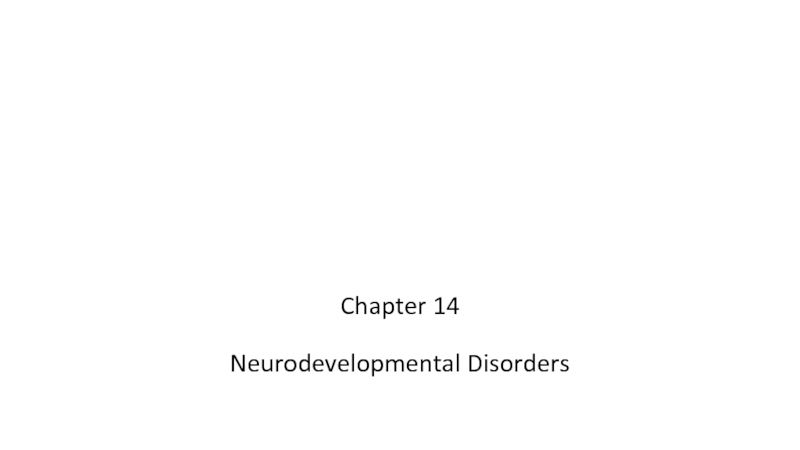
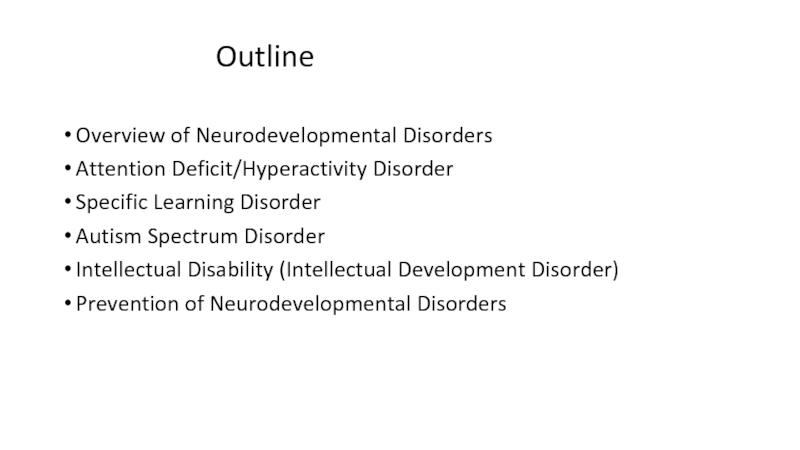
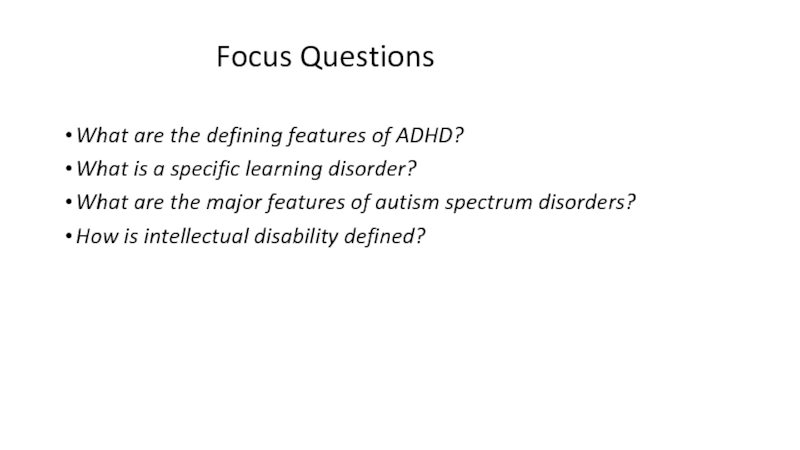
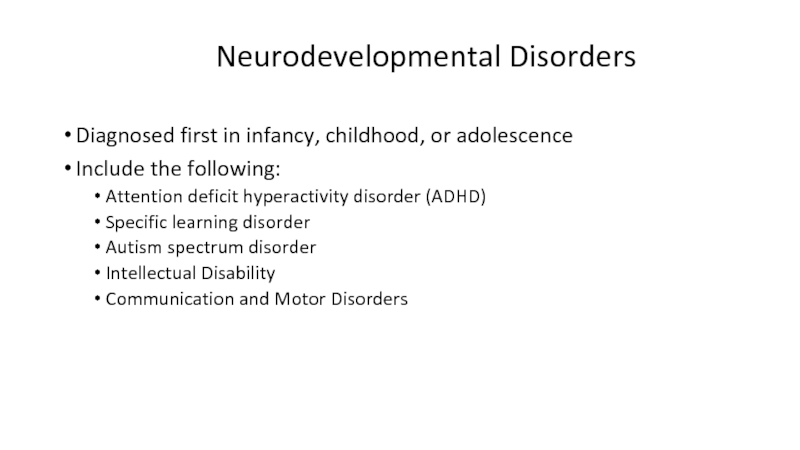
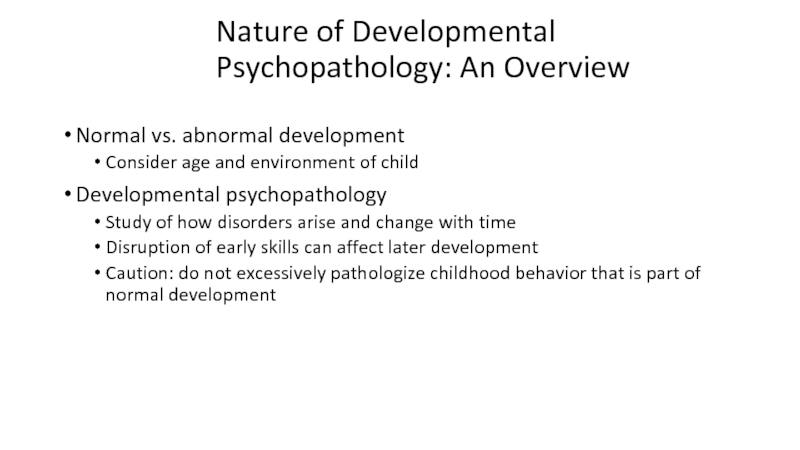
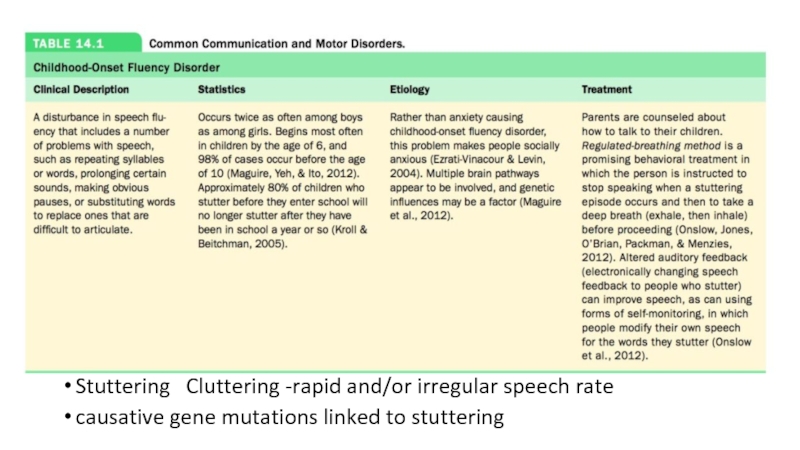
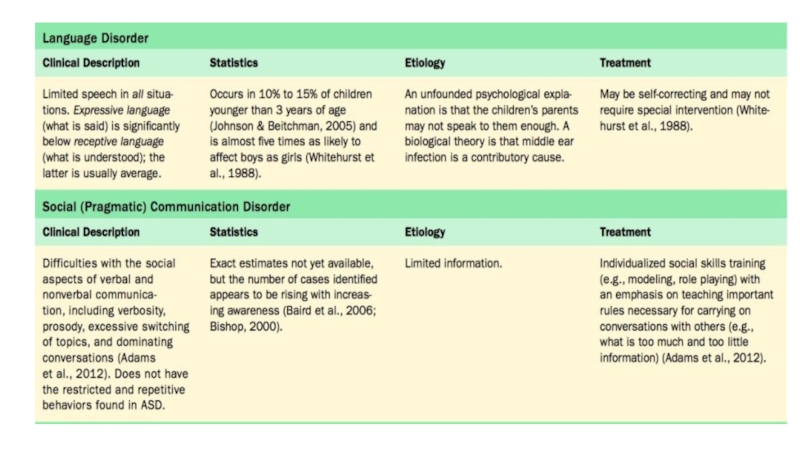



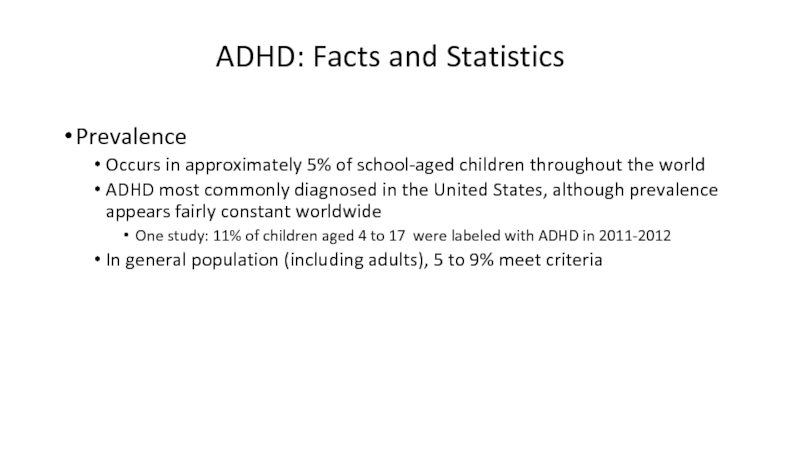
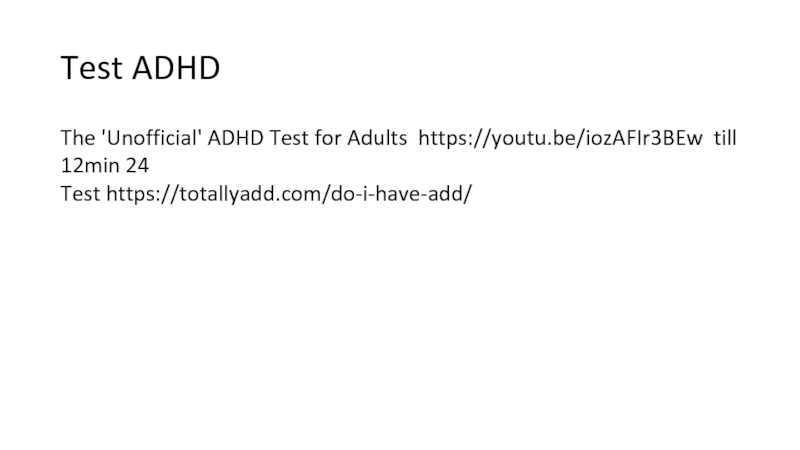
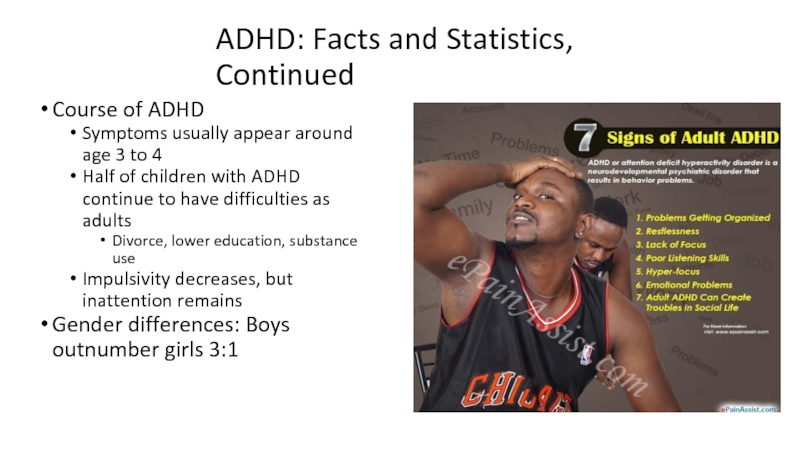
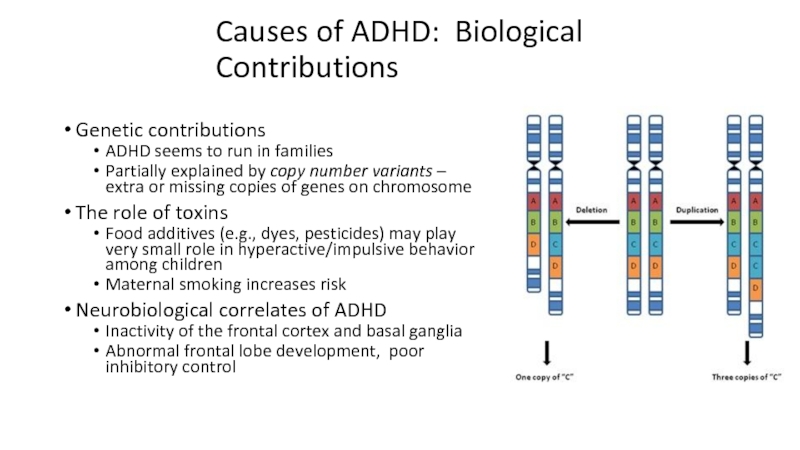




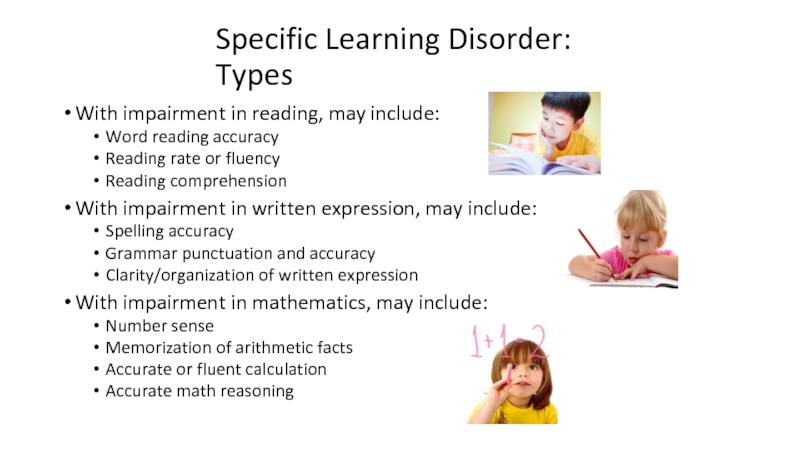
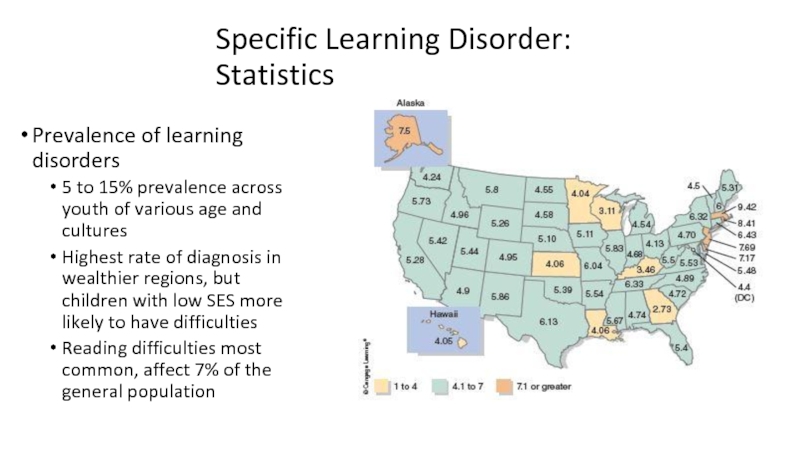
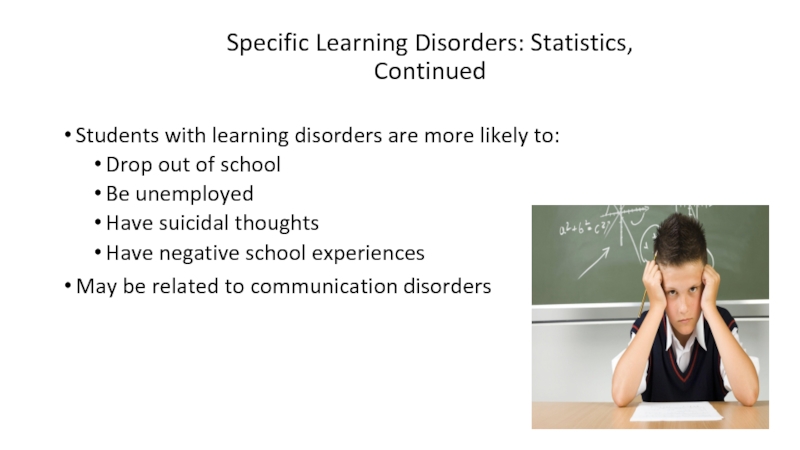


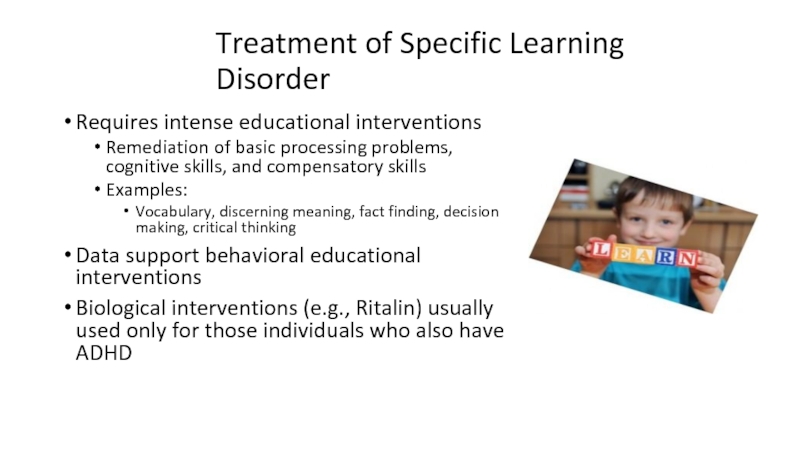

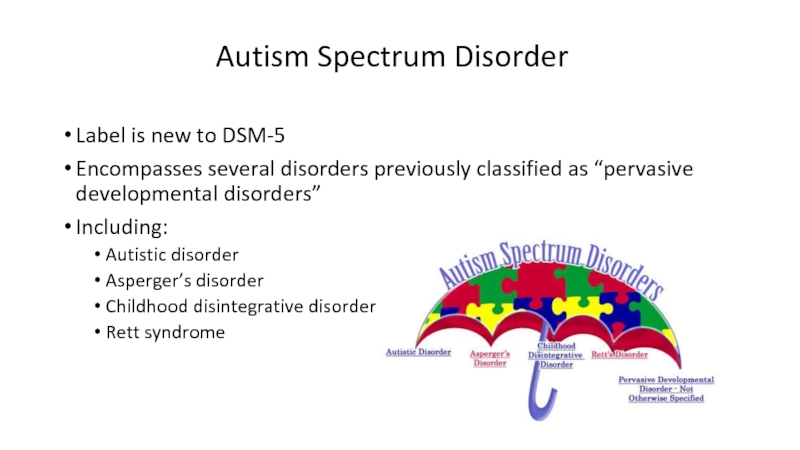
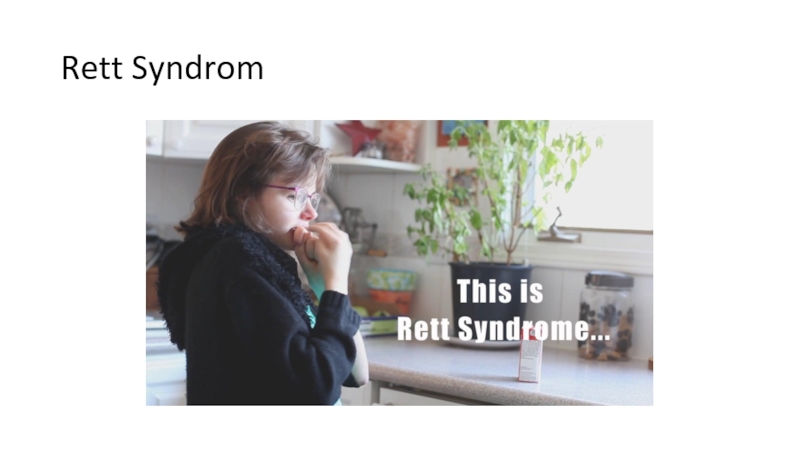

![Chapter 14 Neurodevelopmental Disorders What Autism Looks Like[INSERT Photo, p. 526 HERE] What Autism Looks Like[INSERT Photo, p. 526 HERE]](/img/tmb/4/304151/bd504f71779cf3e07904194203f65259-800x.jpg)

